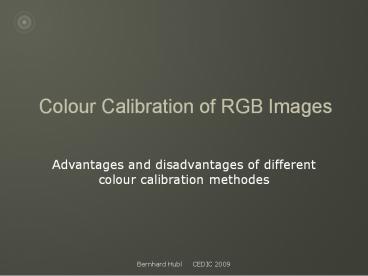Colour Calibration of RGB Images - PowerPoint PPT Presentation
Title:
Colour Calibration of RGB Images
Description:
Advantages and disadvantages of different colour calibration methodes. Contents ... 25 photographers. 2200 images. 780 different objects. price 14. ... – PowerPoint PPT presentation
Number of Views:182
Avg rating:3.0/5.0
Title: Colour Calibration of RGB Images
1
Colour Calibration of RGB Images
- Advantages and disadvantages of different colour
calibration methodes
2
Contents
- Field Stars Calibration
- G2 Star Calibration
- Procedure
- Disadvantages
- B-V Calibration
- Workflow
- Experiences
- Alternative Methodes
- Summary
3
Why Colour Calibration?
- Atmosphere
- Zenith distance
- Transparency
- Telescope
- Filters
- Camera
4
White Balance
- Average of field stars white
- Sunlight white
- Stars with sun-like spectral type (G2)
- Stars with sun-like photometry (B-V)
5
Contents
- Field Stars Calibration
- G2 Star Calibration
- Procedure
- Disadvantages
- B-V Calibration
- Workflow
- Experiences
- Alternative Methodes
- Summary
6
Field Stars Calibration
- Assumption
- Average colour of bright field stars is white
- Advantages
- Easy (e.g. AIP4Win)
- Independent of atmospheric extinction
- Works fine for galaxy fields
- Disadvantages
- Open star clusters
- Interstellar extinction
- Bright nebulae
7
Contents
- Field Stars Calibration
- G2 Star Calibration
- Procedure
- Disadvantages
- B-V Calibration
- Workflow
- Experiences
- Alternative Methodes
- Summary
8
Extinction
9
Extinction
10
Workflow G2 Star Calibration
Measurement of bright G2 star
Exposure of object in specific altitude
Calculate extinction
RGB weights in zenith
Corrected RGB- weights
11
When does the G2 calibration fail?
Measurement of bright G2 star
Exposure of object in specific altitude
Calculate extinction
RGB weights in zenith
Corrected RGB- weights
- No measurement of a G2 star
- Very low altitude of the object
- Bad transparency (clouds, fog,..)
12
Object exposures for G2 star calibration
- Idea Search for not saturated G2 stars
- Two problems
- Spectral type of faint stars is often unknown
- Reddening of G2 strars by interstellar dust.
13
Contents
- Field Stars Calibration
- G2 Star Calibration
- Procedure
- Disadvantages
- B-V Calibration
- Workflow
- Experiences
- Alternative Methodes
- Summary
14
B-V Calibration
- Idea Peter Riepe Harald Tomsik
- VdS Journal 2526
- Calibration uses the object image
- Instead of spectral type -gt photometry
- Comprehensive photometric data of faint stars
- Johnson-Cousins UBVRI filter system.
15
UBVRI Filter
- U Ultraviolet
- B Blue
- V Visual (Green)
- R Red
- I Infrared
16
Colour Index
- difference of the brightness measured through
two different filters - e.g B-V, V-R
Sp. type Colour B-V mag
Spica B1 Blue -0.23
Deneb A2 Blue-White 0.09
Sun G2 White 0.65
Betelgeuse M0 Orange-Red 1.50
17
HR Diagram
18
(No Transcript)
19
Idea
- Colour index of a G2 star without interstellar
extinction - B-V0.65 mag
- V-R0.36 mag
- Search for white stars inside the image field
- Not saturated
- 0.6 mag lt B-V lt 0.7 mag
- 0.2 mag lt V-R lt 0.6 mag
- Measurement of the brightness of selected white
stars in Red, Green and Blue.
20
B-V Workflow
- Preprocessing
- Dark, Flat
- Registration
- Averaged R, G and B image
- Aladin B-V steps
- Load DSS image
- Load photometric catalogue
- Load filter
- Measure brightness of selected stars
21
Step1 Load DSS image
DSS Digitized Sky Survey Aladin
http//aladin.u-strasbg.fr/aladin.gml
22
Step1 DSS
23
Step2 Load Photometric Catalogue
NOMAD1 Naval Observatory Merged Astrometric
Dataset Advantage 100 sky coverage Disadvantage
Accuracy
24
Step3 Load Filter
- Select white stars
- 0.6 lt B-V lt 0.7
- 0.2 lt V-R lt 0.6
- Save Wolfgang Pirachers filter on your local disk
25
Step3 Filter
26
Step3 Filter
27
Aladin - Filter
28
Step4 Measurement
- Aperture photometry of standard image processing
software (e.g. AstroArt) - Result 3 ADU values (R,G and B)
- Example
- Red 48298 / Green 56917 / Blue 51635
- -gt Green and Blue are too bright
- -gt Red 1,00 / Green 0,85 / Blue 0,94.
29
Experiences with B-V
- Methode is laborious
- NOMAD1 catalogue
- Inhomogeneous
- Is based partly on plate scans
- The fainter the reference stars, the more
unreliable - -gt at least 5 stars are necessary (outliers)
- The blue weight is often too high
- Average between G2 and B-V.
30
Contents
- Field Stars Calibration
- G2 Star Calibration
- Procedure
- Disadvantages
- B-V Calibration
- Workflow
- Experiences
- Alternative Methodes
- Summary
31
Alternative Methodes
- Regim by Andreas Rörig
- Up to 5 stars manual selection
- Theli by Mischa Schirmer
- LINUX software
- Astrometric registration
- Fully automated B-V methode Usage of a big
number of stars, which are found by the software
(Vizier data base). - SDSS
- Much better photometric data
- Filter system ugriz (u-g1.43mag g-r0.44mag)
- At the moment far away from full sky coverage.
32
Summary
- New catalogues
- In several years much better catalogues compared
with NOMAD1 - Fully automated B-V methode is possible
- E.g. Theli
- B-V methode as standard
- The B-V calibration works in all thinkable
situations (bad transparency, Milky Way
fields,..), provided that the used catalogue is
enough accurate. - Best procedure at the moment
- Combination of G2 and B-V
33
CCD-DVD Observatory Gahberg
- 25 photographers
- 2200 images
- 780 different objects
- price 14.-
34
Thank you very much for your attention!































